Fire Blight of Apple and Pear
Fire blight is a destructive bacterial disease of apple, pear and other related species such as hawthorn, quince and mountain ash. It causes severe blighting of blossoms, shoots, limbs and fruit. Outbreaks of fire blight occur periodically in British Columbia pear and apple orchards.
Symptoms:
Fire blight symptoms may appear on the blossoms, shoots, branches, trunk and rootstock. Blighted blossoms appear wilted, shriveled and brown. Young fruitlets are also very susceptible and appear water soaked and slightly off-colour soon after infection. Fruitlets quickly turn brown to black and eventually shrivel up.
Blighted pear shoots are black in colour, while infected apple shoots are usually a lighter shade of brown. Infected shoots (or "strikes") wilt rapidly, and often form a shepherd's crook at their tips. During warm and humid or rainy weather drops of milky to amber coloured bacterial ooze frequently appear on the blighted shoots and fruit. Blighted leaves may remain attached to the tree throughout the winter. When shoots attached to scaffold limbs or trunks are attacked, the pathogen may spread into the structural wood causing cankers. In susceptible hosts or young trees the disease may travel rapidly down branches causing girdling and death of the branches or sometimes the main trunk.
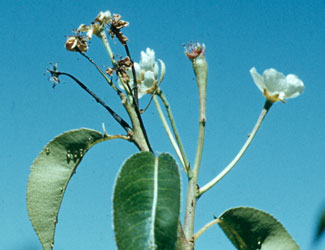 |
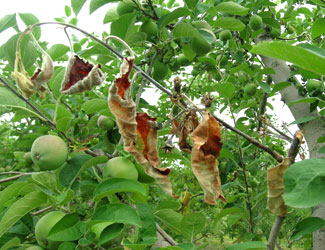 |
| Blossom blight on pear. Note blackening of pedicels (flower stems) | Shoot blight on apple. Note browning of leaves and shepherd's crook and at end of shoot. |
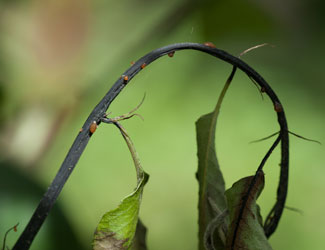 |
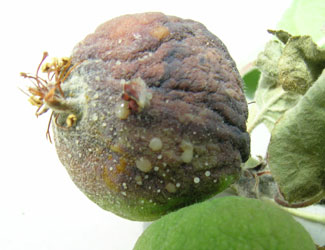 |
| Droplets of amber coloured bacterial ooze on fire blight-affected pear shoot | Fire blight-infected apple fruitlet, with bacterial ooze |
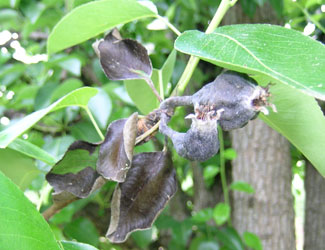 |
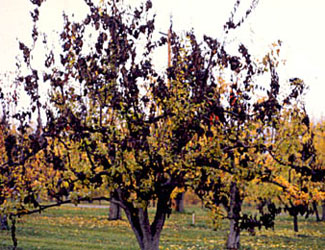 |
| Shoot blight on pear. Note blackened leaves and fruitlets | Pear orchard heavily damaged by fire blight |
Cankers appear as slightly darker, water soaked areas in the wood, which may produce amber coloured bacterial ooze that runs down the bark. Reddish brown streaks may be seen in the cambium under the bark of diseased branches. Later in the season the bark often cracks around the margins of the canker.
Shoot blight caused by reactivating cankers in the spring is known as canker blight. Bacteria that overwintered in holdover cankers begin to multiply and invade nearby shoots or water sprouts. Invaded shoots wilt and die, and may be mistaken for early shoot blight. Cankers may also expand to girdle limbs.
Fire blight may also spread into the root area, leading to tree death. Rootstock blight may not exhibit typical fire blight symptoms. It is sometimes mistaken for crown rot due to brown discoloured tissue under the bark at the base of the tree. Trees may weaken and die beginning one to several months after planting. Oozing bark may be observed near the base of the tree.
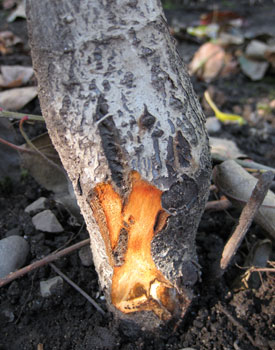 |
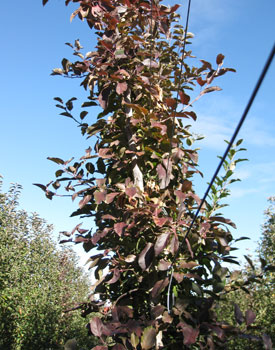 |
| Fire blight rootstock blight. Note red-brown discolouration under bark | Leaf discolouration in late summer caused by fire blight rootstock blight |
Life Cycle:
Fire blight bacteria overwinter primarily in cankers on infected trees. During spring and early summer, cankers that were not removed the previous season may reactivate and produce bacterial ooze, which may or may not be visible. This ooze, consisting of millions of bacterial cells, is easily transported to blossoms by insects such as flies, ants, and beetles. If weather conditions are warm and humid, the bacteria are able to multiply rapidly in the blossom nectar. Bacteria can then be spread very efficiently from blossom to blossom by honey bees. This gives fire blight explosive potential if the conditions for blossom infection are met.
Once blossoms are infected, the bacteria can quickly spread into shoots and branches. Blossom infections become visible as "strikes", or dying shoots in anywhere from 1 to 4 weeks, depending on the temperature.
Infected shoots provide additional sources of fire blight bacteria, which can be spread by rain, (especially wind-blown rain), insects, and contaminated pruning tools. Secondary infections may continue to occur throughout the growing season. The worst epidemics always follow blossom infection. However, it is possible for twig or shoot infection to occur in orchards where little or no blossom infection was found. In these situations the disease pressure is usually low and the damage is more easily controlled. Bacteria can enter the host through both wounds and natural openings such as lenticels. Hail storms often result in severe fire blight outbreaks if inoculum is present in an orchard. Wind damaged leaves are also susceptible to infection.
Fire Blight Management - Cultural Control
Dormant Season:
Overwintering cankers should be cut out during the dormant season to reduce sources of bacteria for the next season. Fire blight cankers have either smooth or cracked margins. Both types of cankers should be removed. The smooth margined cankers are harder to see, but they are also more likely to be active than rough margined cankers. Active cankers may enlarge in the spring causing further structural damage. They also provide inoculum for new infections.
One or more separate operations to prune out cankers are recommended. Since cankers may be hard to locate, it is always best to go over the orchard several times. Cankers are most visible on bright, sunny days. Make cuts 15-30 cm below the canker margins. It is not considered necessary to sterilize pruning tools during the dormant season. Do, however, disinfect your tools if spring pruning is extended into late spring when temperatures have warmed up and/or the budburst stage has arrived. These conditions may also reactivate the infectious bacteria in cankers. In fact, an additional inspection for cankers around the budburst stage may reveal cankers that were missed earlier.
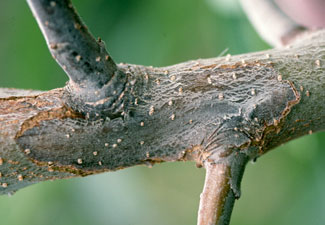 |
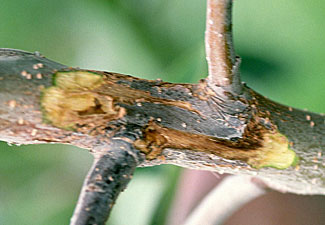 |
| Fire blight canker on apple | Fire blight canker with bark removed to show discoloured cambium. |
Growing Season:
Remove current season infections as soon as they are noticed. Prune out infected branches at least 30-40 cm below the visibly diseased part. This is necessary as bacteria are usually present beyond the discoloured area. Dip tools in a disinfectant between each cut. Flag trees that have been pruned, and watch for further symptoms or the development of cankers. Prunings should be removed and burned immediately.
Scout for new fire blight strikes every 3 or 4 days. Frequent scouting will aid removal of new infections before they have a chance to invade the structural wood.
Where infections occur on shoots attached to scaffold limbs or the trunk, it is not always possible to cut back 30 cm without sacrificing the limb or even the tree. An option on large trees is to scrape out discoloured inner bark using a hatchet or knife, down to clean wood, and disinfect the cut surface.
Cankers often form at the sites of pruning wounds, where blight was cut out during the summer. Such cankers may be hard to detect. To overcome this problem, it is sometimes recommended that a short (10 cm) stub be left beyond the next healthy spur or branch union when pruning out strikes. Remove the stub later, during dormant pruning. Marking the stubs with bright paint will make them more visible.
During severe epidemics, give priority to young trees and high density plantings. Concentrate on salvaging as much of the tree structure and bearing surface as possible. Excessive pruning during the summer will encourage a late flush of growth, which will be susceptible to continued infections.
Summer pruning (other than removal of strikes) should be avoided during a serious outbreak, due to the danger of spreading the disease. If there is any fire blight in the area, disinfect your tools while summer pruning. Avoid pruning during wet weather or when storms are expected within the next 24 hours.
Root suckers and rootstock sprouts may put the entire tree at risk if they become infected. Common dwarfing rootstocks such as M9 and M26 are highly susceptible to blight. Do not cut rootsuckers or rootstock sprouts during a blight outbreak, because the wounds may become infected. They may be safely removed during the dormant season.
Disinfectants:
Good disinfectants for tools include household bleach (eg. Javex, Chlorox), Lysol Concentrated Disinfectant, and PineSol, as well as commercial disinfectants such as Chemprocide. Mix according to label instructions. Bleach can be diluted up to 1:5 with water, and needs to be mixed fresh every day. Tools can either be dipped into, or sprayed with the disinfectant solution. If you use bleach, be aware that it will corrode metal tools and damage your clothing. Ideally, tools should be disinfected after every cut. Dilute disinfectant can also be sprayed on the bark after cutting out an infected branch.
Management Practices:
There are several management practices that can reduce the severity of fire blight. Practices that reduce the vigour of the trees tend to reduce fire blight, because young, fast growing tissue is the most susceptible to infection.
Don't over fertilize the trees. Excess nitrogen causes vigorous shoot growth, which is more susceptible. Nutrient application should be balanced, preferably based on soil and leaf analysis. Application of fertilizer should also be timed to avoid a late flush of growth, because late season infections are more likely to produce cankers that allow the bacteria to overwinter.
Do not run overhead sprinklers while blossom is present on the tree and weather is favorable for fire blight infection. Overhead irrigation may increase fire blight by splashing bacteria around from tree to tree, and by increasing moisture and humidity levels in the canopy. Cutting back on irrigation may also help to slow down over-vigorous trees.
Control insects with sucking mouthparts such as aphids, leafhoppers and pear psylla. These insects can spread fire blight.
Chemical and Biological Control:
Products recommended for fire blight control in Canada include antibiotics, several biopesticides, a growth regulator, and copper sprays. These products are all used preventatively. There are no treatments that can cure fire blight after infection has occurred.
Timing of fire blight sprays is critical. Read the sections on blossom protection and forecasting fire blight for more information.
Also see the Tree Fruit Production Guide for application rates.
Table 1. Products Registered for fire blight control or suppression in Canada
Always follow label directions and precautions when using pesticides.
| Product | Resistance Group | Crops | PHI (days)* | Timing | Notes |
| Kasumin (kasugamycin) | Group 24 bactericide, antibiotic | all pome fruit | 90 | open blossom only | Preventitive. Provides 2-3 days of protection. Maximum 4 applications/ season. |
| Streptomycin 17 WP | Group 18 antibiotic | apple, pear | 50 (apple); 30 (pear) | open blossom only | Preventitive. Provides 2-3 days of protection. Maximum 3 applications/ season. Do not tank mix witih other pesticides. Refrigerate Product. |
| Blossom Protect (Aureobasidium pullulans) | biopesticide | all pome fruit | n/a | open blossom only | Preventative. Apply up to 4 times at 10%, 40%, 70% and 90% open blossoms, or 5 times when model indicates risk of infection. Do not tank mix with fungicides. |
| Bloomtime Biological FD (Pantoea agglomerans) | biopesticide | apple, pear | n/a | open blossom only | Preventative. Suppression only. Apply at 15-20% bloom, followed by a second application at full bloom to petal fall. Maximum two applications per season. Not compatible with copper. Keep frozen prior to use. |
| Serenade Max (Bacillus subtilis) | biopesticide | all pome fruit | n/a | open blossom only | Preventative. Suppression only. Apply at early (1-5%) bloom. Repeat at 4-7 day intervals during high risk periods during bloom. |
| Double Nickel (Bacillus amyloliquefaciens) | biopesticide | all pome fruit | 0 | blossom and post-bloom | Preventative. Suppression only. Compatible with copper. Can be applied post-bloom for shoot blight management. |
| Apogee (prohexadione ca) | growth regulator | apple | 45 | 2.5 – 7.5 cm of new shoot growth | Suppresses fire blight by decreasing host susceptibility. Apply at 2.7-7.5 cm shoot growth; repeat at 14-21 day intervals up to 4 times/season. Will also reduce shoot growth. Do not use on pear. |
| Cueva Commercial (copper octanoate) | Group M fungicide/ bactericide | all pome fruit | 1 | Dormant, bloom and in-season | Preventative. Less likely to cause russet injury than other coppers. Use highest rate for dormant application. |
|
Guardsman Copper Oxychloride (copper oxychloride) |
Group M fungicide/ bactericide | pear | n/a | blossom | Use with caution due to risk of fruit russet. Do not use on apple or anjou pear. |
| Copper Spray Fungicide (copper oxychloride) | Group M fungicide/ bactericide | apple, pear | n/a | silvertip, blossom, post-harvest | Do not use during blossom on apple or Anjou pear. May cause fruit russet. Dormant copper applications have been shown to reduce or delay the production of inoculum in overwintering cankers. |
| Copper 53W (copper sulphate) | Group M fungicide/ bactericide | apple, pear | n/a | blossom | Use with caution due to risk of fruit russet. Mix with hydrated lime to prepare Bordeaux mixture as per label. Do not tank mix with other pesticides. |
* Pre-harvest interval.
Resistance Management: Both Kasumin and Streptomycin are at high risk of resistance development by fire blight bacteria. Streptomycin resistance is known to occur in the Okanagan Valley and throughout most of the Pacific Northwest. To help preserve effectiveness of these products:
- Use only when necessary, when weather conditions create a risk for fire blight
- Never use Streptomycin or Kasumin after the blossom stage
- Do not use Streptomycin more than 3 times per season or Kasumin more than 4 times per season.
- Alternate with other fire blight products.
Blossom Protection and Spray Timing:
Warm temperatures, along with rain, dew or high humidity, favour blossom infections. In British Columbia, favourable fire blight weather during the main blossom period was rare in the past, but has become increasingly more common in recent years. Favourable conditions are even more likely to occur in late spring and early summer with secondary bloom. Spraying for blight is not necessary until daytime temperatures reach the low to mid 20's C. Several warm days in a row during bloom will greatly increase the risk. See section on forecasting fire blight for more information.
Blossom infection may be reduced by spraying with Kasumin, Streptomycin, Blossom Protect, Serenade, Bloomtime, Blossom Protect, Double Nickel, Cueva or fixed copper. Apply preventatively in early bloom when weather is favourable for blight. Repeated sprays at 48-72 hour intervals may be necessary if weather conditions remain warm and moist while blossoms remain on the tree.
Biopesticides should be used as part of an integrated fire blight management program, which includes using a risk assessment model, as well as cultural controls and antibiotics when necessary. For best results, apply a biopesticide during early bloom at the beginning of a warming trend, and follow with a streptomycin or Kasumin spray 2 or 3 days later if warm temperatures continue to favour blossom infection.
Forecasting Fire blight:
There are several models available which can be used to forecast fire blight blossom infection based on the weather. They can be used to determine whether or not sprays are needed to protect bloom.
The Cougarblight model, developed by Tim Smith at Washington State University, is very easy to use. It is necessary to note the daily maximum temperatures while open blossom is present, and determine whether blossoms have been wetted by rain, irrigation or heavy dew. Daily risk values based on temperature are added up over a 4 or 5 day period. Once a certain threshold is reached, there is risk of blossom infection.
Cougarblight is now integrated into the BC Decision Aid System (DAS). To use DAS, set up a free account, select a weather station near your orchard, and add the fire blight model. DAS Spray recommendations are linked to the BC Tree Fruit Production Guide.
Post-Bloom:
Most fire blight products registered for control or suppression of blossom blight are not effective after petal fall. Cueva and Double Nickel are the only registered fire blight products that can be used after bloom. Apply as soon as possible following hail or wind storm damage in blocks affected by or exposed to fire blight.
Physical removal of late or secondary blossoms would greatly reduce the risk of fire blight infection. Although labour intensive, this could be feasible on young trees that are at high risk of infection.
Post-harvest:
Post-harvest application of fixed copper or Bordeaux mixture in the fall could be considered in orchards with a late flush of growth and an active fire blight problem.
Dormant season:
Dormant application of fixed copper or Bordeaux mixture in the spring will help to delay production of inoculum on overwintering cankers. Apply to runoff around the silver tip to green tip stage.
Varietal Resistance
Varieties rated as susceptible are more likely to have fire blight problems. The disease is more severe on pear, but susceptible apple varieties can also be hard hit. See below for susceptibility ratings of apple and pear varieties.
Factors Affecting Susceptibility:
Susceptibility to fire blight can be influenced by many factors, including tree nutrition, irrigation management, soil factors, and cultural practices in the orchard. Young trees are more likely to be severely damaged or killed than older trees. Varieties which have a late or prolonged blossom period are more likely to have bloom on the tree when the weather warms up, and are therefore more likely to suffer from blossom blight. Even relatively resistant trees, such as Red Delicious, may get fire blight after a hail storm or if they are in a mixed planting with susceptible varieties or pears.
Relative Fire Blight Resistance of Apple and Pear Varieties and Rootstocks:
Apple:
- Most Resistant: Red Delicious, Liberty, Enterprise, Freedom
- Moderately Resistant: Golden Delicious, Empire, Granny Smith, McIntosh, Mutsu, Spartan, Summerred, GoldRush, Nova Easygro
- Susceptible: Braeburn, Fuji, Gala, Ginger Gold, Idared, Jonagold, Rome, Winter Banana
Crabapple:
- Moderately Resistant: Dolgo
- Susceptible: Manchurian, Snowdrift
Pear:
- Susceptible: Anjou, Bartlett, Bosc, Cascade, Flemish Beauty, Starkrimson
Asian Pear:
- Most Resistant: Seuri, Shinko, Singo
- Moderately Resistant: Kosui, Chojoro, Shinsui
- Susceptible: Hosui, Shinseiki, 20th Century
Apple Rootstocks:
- Most Resistant: M.7
- Moderately Resistant: MM.106, MM.111, M.4
- Susceptible: M.9, M.26, M.27, Mark, Ottawa 3, B.9
Pear Rootstocks:
- Most Resistant: Old Home (OH), Old Home x Farmingdale (except OHF 51)
- Susceptible: Bartlett seedling, quince
(Note: Resistance ratings are not exact, and can be influenced by growing conditions)
Fire Blight Prevention
If you are growing susceptible varieties, be aware that fire blight may strike. Keep your eyes open for symptoms while working in the orchard, and periodically inspect your crop for blight. Take immediate action if you find anything suspicious. Have the disease confirmed by a field advisor or plant pathologist. If fire blight was in your orchard or a nearby orchard the previous year, be sure to monitor for fire blight favourable weather during bloom and apply preventative sprays if necessary.
You can minimize the chances of introducing fire blight into your orchard by selecting nursery stock from a reliable source. Ask your supplier if they have had fire blight problems in the nursery. The varieties and rootstocks you grow will also influence the potential for fire blight.
Summary
Fire blight poses a serious threat to new and established orchards of apple and pear. Fire blight has a tendency to appear in unexpected places. It could be well worth your time to regularly scout for symptoms in your orchard, even if you've never had fire blight before. Successful fire blight control requires good management. The following summary lists the major management practices used to control fire blight:
Dormant season
- remove cankers and dead branches
- delayed dormant copper spray
Blossom stage
- monitor temperature during blossom
- apply preventative sprays during blossom if blight-favourable conditions are forecast. For example, apply a biological treatment in early bloom followed by an antibiotic if the weather remains favourable for fire blight.
- consider Apogee for shoot blight suppression in blocks at risk of fire blight. Must be applied early.
Post bloom
- scout for and remove strikes at regular intervals
- disinfect tools between cuts
- control aphids, leafhoppers and pear psylla
Post harvest
- apply copper sprays if fire blight is active
- continue to remove new infections
Further Information
- Fact Sheet – Integrated management of fire blight on apple and pear in Canada - Agriculture and Agri-Food Canada
- Fire blight - Washington State University
Updated July, 2018
